|
Thread Number: 33730
NON USA Dryers; what is typical, electric, gas, clothes line? |
[Down to Last] |

|
| Post# 506949 , Reply# 2 3/26/2011 at 09:53 (4,778 days old) by 3beltwesty () | ||
|
wow, Thanks Matt! As a related side question is Natural Gas plumbed it to houses common or not so common? Here in the USA in built up areas NG is rather common in many areas, and often used for heaters to heat the house in winter. | ||
| Post# 506951 , Reply# 3 3/26/2011 at 10:43 (4,778 days old) by paulc (Edinburgh, Scotland) | ||
My aunty
has a matching USA Whirlpool washer dryer set but she is the only person I know with a US dryer.
I myself do not have a dryer anymore. In our last place I had a Zanussi condenser dryer but as we get "free" heat and hot water in the place we are now and I have room to dry in doors I Have a big clothes horse I use in the winter. In the summer I hang washing out, weather permitting. | ||
Post# 506977 , Reply# 5 3/26/2011 at 12:55 (4,778 days old) by foraloysius  (Leeuwarden, Friesland, the Netherlands) (Leeuwarden, Friesland, the Netherlands) |
||

Overhere in the Netherlands we have huge resources of natural gas, almost every house is connected to it.
There are hardly any gas dryers on the market here anymore. Except for the Huebsch (see link). But I have never seen one of those. Miele had a gas dryer for a while in their line of dryers, but apparently these didn't catch on. Actually most dryers sold on the Dutch market are condenser dryers. And the heatpump dryers are getting more popular. Those types can only be made as electric dryers ofcourse. In a lot of households the washer and dryer are placed in a bathroom, so a gas line is usually not available there. Besides that I think it's forbidden overhere to have gas appliances in a bathroom. CLICK HERE TO GO TO foraloysius's LINK | ||
| Post# 507032 , Reply# 11 3/26/2011 at 16:25 (4,778 days old) by ronhic (Canberra, Australia) | ||
 I use my dryer weekly for towels and underclothes - I like them soft against the skin without conditioner...
Other than that, I line dry.
From my machine spun at 1200rpm, and in a much dryer climate than Nathan, sheets are dry on the line in about 45 min in summer with no breeze and well under 45min with one....
Those same sheets in the dryer in an Australian dryer take about 45min in summer and just under an hour in winter....
If you told people you 'tumble dry everything', you'd be just about crucified in this country....even if you lived in a flat! Even in winter and wet weather, my mother frowns upon it... | ||
Post# 507034 , Reply# 12 3/26/2011 at 16:43 (4,778 days old) by Launderess  (Quiet Please, There´s a Lady on Stage) (Quiet Please, There´s a Lady on Stage) |
||
Speaking Only For The One Country Am Really Familar With
France,
If one has the room and can afford it, then it's one of the electric Euro dryers (condenser of course). For most however there is the age old French laundry day ritual, draping wet laundry over every available surface, indoor clothes lines, drying racks,out door balconies or railings, and so forth to dry. The above applies to mostly those living in cities/urban areas. Obviously living in the country and or a private house one would have other options. | ||
Post# 507035 , Reply# 13 3/26/2011 at 16:44 (4,778 days old) by foraloysius  (Leeuwarden, Friesland, the Netherlands) (Leeuwarden, Friesland, the Netherlands) |
||
 | ||
Post# 507037 , Reply# 14 3/26/2011 at 16:49 (4,778 days old) by Launderess  (Quiet Please, There´s a Lady on Stage) (Quiet Please, There´s a Lady on Stage) |
||
And Furthermore
Given the small (ok cramped, *LOL*) size of many urban French apartments, you are only going to find 5kg or so capacity washers anyway. Doing laundry then requires planning, and most certainly isn't the once a week or two week event as in the USA.
You simply do wash as it is ready, usually early in the morning or late at night, drape/hang things up to dry and either leave for work/shopping/etc or go to sleep. King sized beds are rare in French apartments, so linens then to be either twin, or full/matrimonial (aka queen), so you aren't bothered by hanging large linens to dry. Of course you can simply skip all this palaver and haul the lot down to a laundromat. One reason for lack of dryers, even in French homes that could well afford one is the dear cost of electric. Given many apartments in France (especially those in older buildings), by code have cross ventilation due to windows on either side, drying does not take long as one might think. | ||
Post# 507038 , Reply# 15 3/26/2011 at 16:56 (4,778 days old) by foraloysius  (Leeuwarden, Friesland, the Netherlands) (Leeuwarden, Friesland, the Netherlands) |
||
 | ||
| Post# 507064 , Reply# 17 3/26/2011 at 18:28 (4,778 days old) by Haxisfan (Europe - UK / Italy) | ||
The 2 countries I know have been covered!
Are collapsible clothes airers allowed? Nice topic here… I just wanted to spill a bit of my personal experience with drying clothes… swearing to keep it as short as possible :-)
I was living with my parents up to 1996 in a southern Italian island where hardly any1 bothers with separate clothes dryers (but washer-dryers are somewhat popular) due to the milder climate (however, it’s not always so) and in my case also due to the availability of an enclosed outdoor space with washing lines. My first personal encounter with a tumble dryer (electric) was when I moved to the UK. I was renting a room in a house provided with such machine, but nobody was using it and I decided to join the fun and spread my wet laundry over the radiators and the stairs handrail. When I moved into my own house some time later I was given a compact tumble dryer by a friend but for some reason I kept using my old methods for several years to come: radiators and handrail! Till 1 day, urged by the presence of others, I decided to give it a go: it didn’t work! Although that wasn’t enough to make me through in the sponge… I went out and got a full size electric vented tumble dryer and I can frankly say that I have been bewitched by this appliance and I can’t do without! Only recently I stopped using the dryer to dry a load right out of the washer… let’s say it’s my little vendetta against the electricity board since my capped prices expired last year, they had been fixed since 2005… and then… all of a sudden… ka-ching, big time… big bill! I have an unused room in which I can put clothes airers in without troubling any1… although I recently got a dehumidifier (uses much less electricity than a dryer) for obvious reasons. My obsession for the tumble dryer is still alive and kicking… I haven’t managed to give up the softness and finish of tumble-dried laundry… so… my clothes go straight there after hanging on the airer even for just a short burst on low heat. Also they fold much easier that way and don’t need ironing ;-) | ||
Post# 507071 , Reply# 19 3/26/2011 at 18:55 (4,778 days old) by mrboilwash  (Munich,Germany) (Munich,Germany) |
||

In Germany the type of drier depends a lot in what type of building one lives.
In an appartement one would typically opt for a condenser drier as it only requires an outlet and can be placed in the kitchen, bathroom or anywhere else. I have mine hidden in the bedroom. In contrast to the UK houses normally have a basement here, so if you live in a house the washer and drier is found in the cellar and in this case a vented drier would still be prefered, I think. Linedrying in and outdoors is still very popular here to save energy. | ||
| Post# 507105 , Reply# 21 3/26/2011 at 22:04 (4,778 days old) by brastemp (Brazil) | ||
|
Sorry Thomas, but I just read this on the electrolux website: eden.electrolux.com.br/Eden_Brazi... | ||
| Post# 507247 , Reply# 23 3/27/2011 at 12:14 (4,777 days old) by 3beltwesty () | ||
|
Thank to all for the SUPER responses; please add more too! | ||
| Post# 507332 , Reply# 32 3/27/2011 at 17:25 (4,777 days old) by Mrx () | ||
|
UK/IRL plug Here's the pic of the UK / Ireland plug type BS1363. Rated 13amps max. (Delivers just shy of 3000W at 230V) 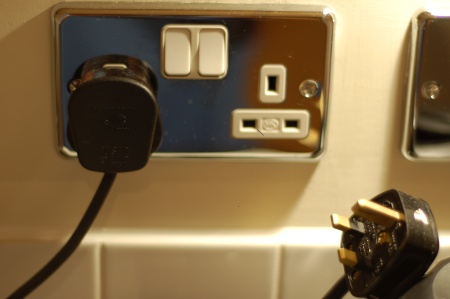
| ||
| Post# 507335 , Reply# 33 3/27/2011 at 17:27 (4,777 days old) by Mrx () | ||
|
Plug fuse Here's where the fuse goes. 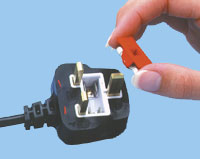
| ||
| Post# 507337 , Reply# 34 3/27/2011 at 17:31 (4,777 days old) by ronhic (Canberra, Australia) | ||
Fuses... All Australian homes are fused at the meter with either 'old style' breakable wired fuses for each particular circuit (lights, hot water, power points etc) or with circuit breakers, as in our case.
We have the following...
30amp - stove 20amp - power 20amp - power 20amp - power 20amp - power 20amp - power 20amp - airconditioner 20amp - airconditioner (was hot water...we've now got gas so the ignition runs off a normal power point) 10amp - lights 10amp - lights
I should add, that this is a very large house given it was built in 1981...330sqm/3600sqft (including garages) and seems to have been 'over fused' for the time....
| ||
Post# 507339 , Reply# 35 3/27/2011 at 17:36 (4,777 days old) by thomasortega  (El Pueblo de Nuestra Señora de Los Angeles de Porciúncula) (El Pueblo de Nuestra Señora de Los Angeles de Porciúncula) |
||
|
Somebody please post a picture of an american standard modern dryer plug and outlet. Please correct me if i'm wrong. gas models usually have the 3 prong plug (2 flat, 1 round) and electric models have the 4 prong "twist to unlock" plug. Am I right? | ||
Post# 507357 , Reply# 36 3/27/2011 at 18:11 (4,777 days old) by Launderess  (Quiet Please, There´s a Lady on Stage) (Quiet Please, There´s a Lady on Stage) |
||
Thing To Remember About Gas
Is that outside of the Untied States it is not always common to find piped natural gas supplies, especially outside of major urban areas. Thus what gas there is, is often tanked propane.
This has much to do with the rather low supplies of natural resources aside from coal, found in most of the EU/UK. IIRC, natural gas to much of the UK is piped from Norway and or other countries up that way where petrol can be found, including their own North Sea operations. Given the old, in some cases very old housing stock in many EU/UK countries installing gas lines could pose a problem. However many homes that were built and or reconfigured to accept coal gas (used for lighting), find those gas lines are still active though it is natural gas coming out of the pipes. Remember watching "1900 House" when they were converting the "modern" Victorian town house back to it's original turn of the last century status. All the workmen had to do was remove the caps/seals from the lighting fixtures, and gas (natural) came out. I lived in an older apartment building in Brooklyn where the gas lines for lighting were still in the walls. One neighbor who had lived for decades in the place told me a story. For years she couldn't figure out why the power company was sending her bills for gas. The only appliance in the apartments that used the stuff was the range, and that was included with the rent. To settle the matter ConEd sent a work crew out to examine the building/apartment. It turned out the gas lines for lighting were still active! Apparently when the buidling was wired for electric no one bothered to seal off the gas for the lines coming from the street. Hard to imagine that for generations residents of that building were *that* close to getting the "Gaslight Treatment* | ||
| Post# 507374 , Reply# 38 3/27/2011 at 18:39 (4,777 days old) by ronhic (Canberra, Australia) | ||
 ...all the bedrooms in this house have 4 x 230v 10amp power points with the main having 6...
Lounge room has 6... Dining room has 4 Family room has 6 Garage has 8 Laundry only 1 (what gives here??? I want 6!) Bathroom has 2 Ensuite 1 Outside 2x2 in diferent locations Upstairs hall has 2 x10amp and 1x15amp (for the airconditioner) Entry 1
...and 11 in the kitchen
There are power points everywhere....trust me, we may have to run power boards for entertainment (TV, amp, DVD...etc), but nothing like we used to.... | ||
| Post# 507388 , Reply# 40 3/27/2011 at 19:08 (4,777 days old) by ronhic (Canberra, Australia) | ||
 | ||
Post# 507574 , Reply# 42 3/28/2011 at 11:40 (4,776 days old) by logixx  (Germany) (Germany) |
||

I ALWAYS use the dryer - it's just part of "doing laundry" for me. Even though we have a rotary clothes dryer in our garden, actually a quite expensive one that retracts the lines into its "arms" when not in use to keep them clean, I never use it. I much prefer using the dryer: no bleaching from the sun, no roughness, no creases and no stink. I know, some people say they love the smell of laundry dried outside but I don't. The air around here is pretty clean - after all, I'm practically surrounded by trees in this area of Germany - yet, I think air-dried clothes smell nasty. I either want them to smell of softener or of nothing. Also, I can't stand to fiddle around with every little sock, piece of underwear etc. etc. No! Just toss it all in the dryer and let the sensors take care of everything.
As for dryers themselves: the most common type of tumble dryer in Germany is the sensor-controlled condenser dryer. Out of the approx. 50 dryers we have on the sales floor, only three are vented and not a single one is time-controlled. We do have (and sell) an increasing amount of heat-pump dryers, as they typically use half the energy of a traditional dryer. Gas dryer are practically non-existent. As are dryers that are larger than 24x24 inches - unless one would get a professional unit, of course. Capacity-wise, the largest drums are 4.2 cu.ft., which is enough for 13 lbs. Yet, some manufacturers claim their dryers hold almost 20 pounds, which, I guess, they do but the result will be a wrinkled mess. Most dryers change drum rotation like a washing machine, although Bosch/Siemens and others make uni-directional dryers these days. Our Electrolux changes direction every five minutes for about 10 seconds. Miele dryers have a sensor that can detect a balled-up load and reverse accordingly. Another difference is the moisture-sensing system: most (all?) US dryer with moisture sensors (not Auto Dry) have metal bars either at the front or back of the drum. Typically, European dryers use the drum vanes as sensors, which works very precisely. Our dryer actually uses the entire drum to sense moisture so even a single item can be dried on a sensor setting! If no clothes are in the drum, it'll shut off within seconds. That's how good the sensors are. Again, some manufactures (Bosch/Siemens) are using the "metal bar" system on their Euro units, too. We also didn't have more than two temp settings until recently. Normal (+/- 158F) or low (+/- 122F). What I wonder is how do US dryers control their five different settings? I suppose they just turn the heater on and off? Especially gas dryers? German dryers - being electric - have two heaters, which they engage according to the temp selected. Our dryer has a 1000W and a 1400W element. Combined or individually, they are cycled throughout the drying process. Full stainless steel drums are the norm. Glass doors can be had from many manufacturers, now. Alex | ||
Post# 507605 , Reply# 43 3/28/2011 at 12:43 (4,776 days old) by hydralique  (Los Angeles) (Los Angeles) |
||
|
Modern Condenser Dryers . . . Are these the type that use some tap water to dissipate the heat from drying, or is there another method? | ||
Post# 507606 , Reply# 44 3/28/2011 at 12:44 (4,776 days old) by joe_in_philly  (Philadelphia, PA, USA) (Philadelphia, PA, USA) |
||
 | ||
Post# 507607 , Reply# 45 3/28/2011 at 12:45 (4,776 days old) by foraloysius  (Leeuwarden, Friesland, the Netherlands) (Leeuwarden, Friesland, the Netherlands) |
||
 | ||
| Post# 507610 , Reply# 47 3/28/2011 at 12:52 (4,776 days old) by 3beltwesty () | ||
|
. 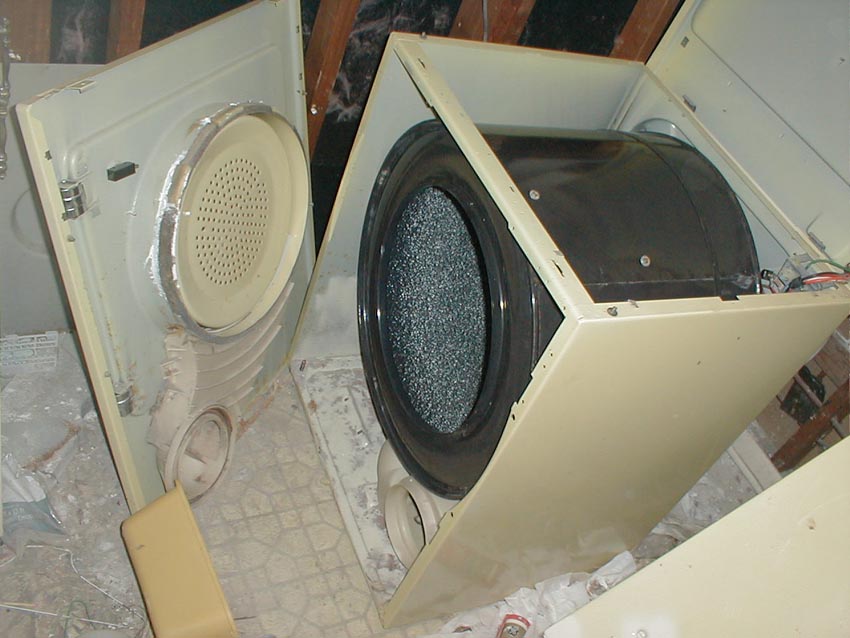
| ||
| Post# 507617 , Reply# 48 3/28/2011 at 13:20 (4,776 days old) by 3beltwesty () | ||
|
. 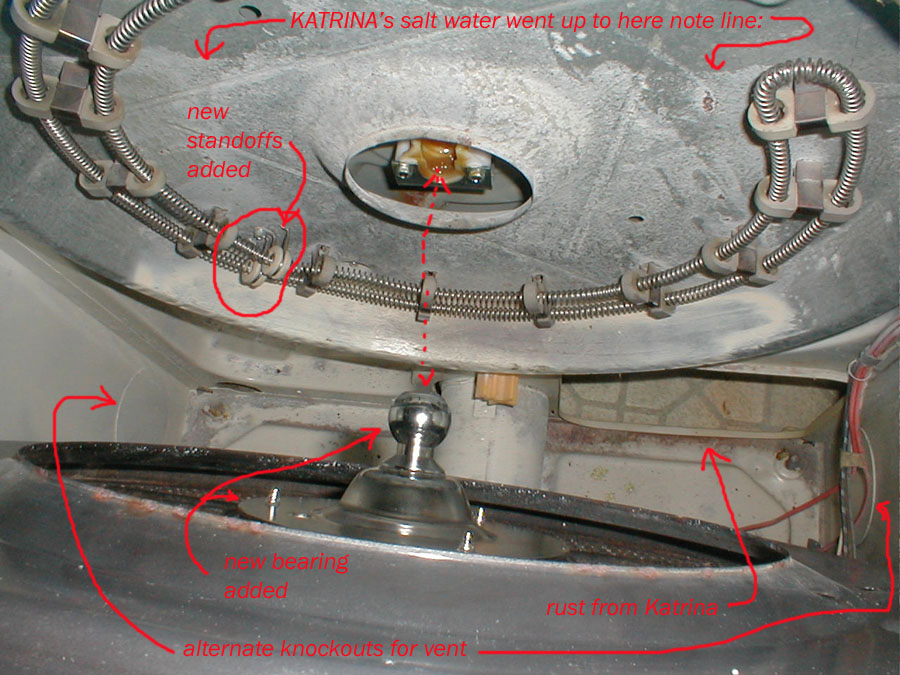
| ||
| Post# 507619 , Reply# 49 3/28/2011 at 13:22 (4,776 days old) by 3beltwesty () | ||
|
2 terminal dumb termostat in output tube/vent . 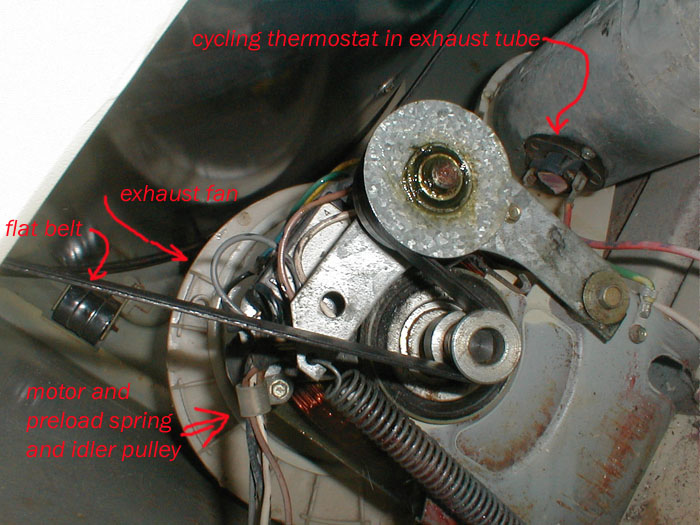
| ||
| Post# 507633 , Reply# 51 3/28/2011 at 14:06 (4,776 days old) by 3beltwesty () | ||
|
2 terminal dumb termostat in output tube/vent . 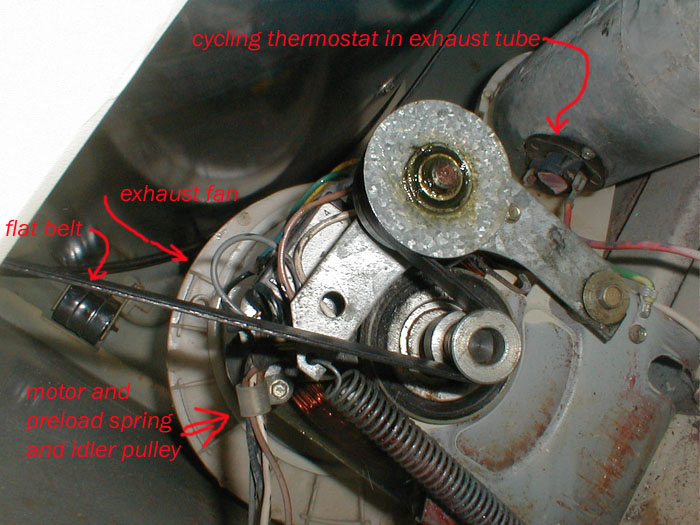
| ||
Post# 507678 , Reply# 55 3/28/2011 at 16:21 (4,776 days old) by Launderess  (Quiet Please, There´s a Lady on Stage) (Quiet Please, There´s a Lady on Stage) |
||
Condenser Dryers
Cannot speak for the rest of Europe, but at least in Paris and other parts of France with strict building zoning, it is either a condenser dryer or nothing. One simply cannot drill holes into walls of those Baron Haussmann buildings to make a vent. Indeed think that applies to most all "older" (and we're talking anything still standing from the 1600's through perhaps built just prior or after WWII. Same goes for air conditioning, which also explains those portable units with ducting that goes out a window.
IIRC, consumer magazine tests on both sides of the pond usually put vented dryers ahead of condensers in terms of drying time. As for water cooled condenser dryers, only remember seeing one of those. It was in our high school's "home ec" suite. For some reason "Whirlpool" sticks in my mind, though many here in the group say it wasn't possible. Only remember teacher having to turn on a water tap behind the machine before starting up the unit. This she complained about bitterly as having to use the thing even during a "water shortage". However can see why it was installed. The classroom suite did not face an exterior wall, and there was no way to run ducting to where it could exit. As the school still stands and is use, wonder if the dryer remains? | ||
Post# 507714 , Reply# 60 3/28/2011 at 18:17 (4,776 days old) by Launderess  (Quiet Please, There´s a Lady on Stage) (Quiet Please, There´s a Lady on Stage) |
||
We Loves Our Air Conditioning
One thing Americans complained of bitterly when visiting the UK/EU was the lack of AC. Those from the otherside of the pond complain bitterly that many American homes,businesses, and or public accomodations are like meat freezers!
One gentleman from Spain even wrote to the New York Times moaning that every shop or place he and his wife visited on their recent trip to NYC that summer were ice cold. He also wondered why something couldn't be done to moderate the temperature. Growing up in the 1970's AC was a luxury, especially whole house central versions. Many persons had a unit in the living room and or perhaps the master bedroom, but that was about it. Then as with all consumer goods as prices came down everyone seemed to have them everywhere. Since neither my nor my siblings bedrooms had AC as we grew up, really am not that bothered sleeping even on a quite hot/humid summer's night. However that applies to "NYC heat", once you get down Sawth things are different. That heat and damp coming off the Gulf can make one puddle in matter of seconds. Think in some ways this move to everyone having ACs killed the fun summer nights of yesterday. I can well remember a hot summer's night would find our street (and most everyone else's one assumes), filled with children playing, adults sitting on the steps/out in the yard etc all because it was simply "too hot inside". People went for drives, or down-town to walk around or even to a movie, lounge or any place else that was "air conditioned". Now you can walk up most areas buck naked on a hot summer night and no one would know. The streets are deserted as everyone is indoors with shut windows enjoying the AC. To me this is why many parts of Europe, especially the furhter south one goes have such a vibrant night life. Having had ages of time to work out how to live with the climate, people adapt. | ||
Post# 507744 , Reply# 64 3/28/2011 at 19:34 (4,776 days old) by Launderess  (Quiet Please, There´s a Lady on Stage) (Quiet Please, There´s a Lady on Stage) |
||
Paris
Must say really am not bothered by lack of AC when in most parts of France, well at least Paris and parts north as well.
Paris is actually a bit north of NYC by latitude, and unlike here it is rare one wakes up to the "dog days of summer" heat common from say late July through August. Yes, Paris can be hot in the afternoon especially in August, but by the time early evening and certainly by nightfall (the sun does not go down until almost well after 9PM in summer), it is much cooler. Indeed one often requires a sweater or jacket if going out. Thus can see how easy it is to get on without AC. One other great thing about Paris apartments is that most are built with cross ventilation, something usually lacking in NYC unless you have a really huge flat. | ||
Post# 507748 , Reply# 65 3/28/2011 at 19:49 (4,776 days old) by combo52  (50 Year Repair Tech Beltsville,Md) (50 Year Repair Tech Beltsville,Md) |
||
ENERGY USE AND DRYERS Air-cooled condenser dryers run hotter and use almost 25% more electricity than vented dryers. No harm meant but Europeans do not take dryers as seriously as we do in the US. Normally the Europeans are very very energy efficient in many ways that that we
could learn from, but I have always been amazed that gas dryers were so uncommon in Europe which proves my point about taking dryers seriously. Also it is about impossible to dry large items like mens jeans in a 24"and get wrinkle free clothes.
| ||
| Post# 507758 , Reply# 67 3/28/2011 at 20:20 (4,776 days old) by Mrx () | ||
|
Yeah, I have to say, no wrinkle problems whatsoever in our dryer. | ||
Post# 507759 , Reply# 68 3/28/2011 at 20:32 (4,776 days old) by Launderess  (Quiet Please, There´s a Lady on Stage) (Quiet Please, There´s a Lady on Stage) |
||
What Was That? What Did You Say About 24" Dryers?
Well as one who spent the weekend doing several loads of wash in the Miele, then drying in a vintage Whirlpool 24" dryer, I take exception to that remark! *LOL*
Towels, T-Shirts, the lot all came out wrinkle free, and that was after loads were spun in the spin dryer for 5 to 7 minutes. If there is anything that will put in creases, a spin dryer will do it. Have also dried jeans in my dryer, but never until they are crispy. Mainly just enough to work out any wrinkles from the final spin cycle, then they are hung up to finish drying. | ||
| Post# 507823 , Reply# 71 3/29/2011 at 03:53 (4,776 days old) by Haxisfan (Europe - UK / Italy) | ||
Issue with wrinkling...
Improper use once again would lead to wrinkles, uneven drying and poor results in general.
Who cares about the max capacity declared by the manufacturer... if you load the dryer no more than half its visible drum size (never mind about the weight of the items in your load) I can assure you that you won't need to iron ever again. In my case my washer spins items continuously for 10 minutes... none of this faffing about for 2-3 minutes... then a little burst of spin and more faffing about! Yet my clothes look as if they've been ironed when I'm done with them: of course I don't expect that they did so by themselves... I indulge into running my hand over them once they've been folded! Having said that there are still some obstinate items that would wrinkle no matter what... regardless of using the dryer... well, I'm thinking of a few pillow cases of mine made of 100% egyptian cotton and they punctually get creases. The get folded and put away without being ironed and by the time I need to use them again they'll be as flat as a pancake! As I've never seen a gas dryer in my life, I was wondering whether these work in a similar fashion as a vented dryer... I would appreciate a confirmation from you folks. Thanks. | ||
| Post# 507833 , Reply# 73 3/29/2011 at 06:39 (4,776 days old) by solsburian (SE Northumberland) | ||
|
My aunt has (or had) a White Knight Gas Dryer and she loved it, I haven't seen her for a while but if she still has it it will probably be 15 years old now. | ||
Post# 507892 , Reply# 77 3/29/2011 at 11:09 (4,775 days old) by combo52  (50 Year Repair Tech Beltsville,Md) (50 Year Repair Tech Beltsville,Md) |
||
24' DRYERS ARE TOO SMALL TO DRY LARGE ITEMS Of coerce you can dry 2 or 3 pairs of jeans with reasonable success in a small dryer. But drying heavy jeans and towels in small batches is a waste of energy and time and wear and tear on the dryer itself. Drying heavy items is a little like baking cake layers in an oven, you can bake two layers in about 30 minutes. But you can bake 6 layers in say 35 minutes using almost no more energy than just baking two.
But I always dry loads of at least 6 jeans or sometimes more than 10 pair per load. Keep in mind that I even think that the 27" dryers that are becoming more popular here are too small for the best results, I will keep my 29 and 31" wide dryers thank you.
I would be willing to bet that the great majority of clothing dried in hotels, hospitals, restaurants etc etc in Europe is dried with gas dryers, they are just the most energy efficient way to dry clothes on any scale.
Heat-pump dryers show great promise and will give gas dryers a run for the money. My brother [ Jeff ] and I designed heat-pump dryers over 30 years ago, while I can't claim that we thought of it first we knew that it was a sound idea that would make sense. | ||
Post# 507918 , Reply# 79 3/29/2011 at 13:14 (4,775 days old) by logixx  (Germany) (Germany) |
||

What I also have to say regarding vented vs. condenser: condenser dryers seem to dry much more evenly when doing mixed loads.
I didn't change sorting habits when using the big Speed Queen dryers at the laundry room of my UK dorm. That is to say, I threw jeans and T-Shirts in at the same time - just like I do at home. At the end of the 30 min. cycle, some items were dry while others were still moist. This doesn't happen with condenser dryers. Everything dries pretty much at the same pace, as the moisture level of the entire load is gradually reduced. Alex | ||
Post# 507951 , Reply# 81 3/29/2011 at 15:59 (4,775 days old) by foraloysius  (Leeuwarden, Friesland, the Netherlands) (Leeuwarden, Friesland, the Netherlands) |
||

Here's a scheme of how an Asko condenser dryers work. All European condenser dryers work similar. The red flow is circulating air in the dryer. In the condenser the air gets cooled by the blue flow. The water that is condensed is pumped into a reservoir or can in most cases be pumped into a drain with a small hose (The hose of my Miele dryer fits together with the drain hose of the washer in one drain pipe).
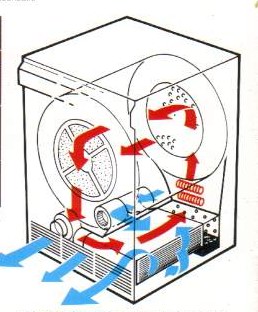
| ||
Post# 507969 , Reply# 82 3/29/2011 at 17:10 (4,775 days old) by Launderess  (Quiet Please, There´s a Lady on Stage) (Quiet Please, There´s a Lady on Stage) |
||
Commerical Businesses And Their Laundry
Again, cannot speak for the rest of the EU/UK, but at least in Paris and many other major urban areas of France the larger hotels, hospitals etc send their laundry out to commercial laundries. There one assumes you are correct in the use of large steam or gas heated vented driers versus condenser models. The volume of laundry is just too large IMHO for anything else.
There is along tradition going back ages for those living in French cities to send their wash either to the country (or out of it). This was originally done in aid of finding fresh water and air (both in short supply at that time). I've stayed at some small hotels in Paris where they did their own laundry, but once you go to the medium or larger places, things can change. As in the United States many businesses simply feel it is "cheaper" in the long run to outsource their laundry. Between labour,machine and supply costs, not to mention costs of staffing, it just makes sense. | ||
| Post# 507971 , Reply# 83 3/29/2011 at 17:24 (4,775 days old) by pierreandreply4 (St-Bruno de montarville (province of quebec) canada) | ||
 | ||
| Post# 507987 , Reply# 84 3/29/2011 at 18:29 (4,775 days old) by cfz2882 (Belle Fourche,SD) | ||
|
american condenser dryers several u.s. appliance manufacturers made condenser dryers around the 1950s, both air and water cooled-i don't know many details so will start a thread in imperial | ||
| Post# 508123 , Reply# 87 3/30/2011 at 05:37 (4,775 days old) by Haxisfan (Europe - UK / Italy) | ||
10 minute final cool tumble:
I always leave my clothes in the dryer overnight (whether they've been on the line beforehand or not) as I'm usually sleeping when the drying cycle has completed... still no creases after a refresh programme. All tumble dryers have a 10 minute cold tumble at the end of any programme to cool down the garments and avoid the creation of wrinkles.
The only problem I've had with a full mixed load is that some of the thicker items might occasionally not be entirely dry as the rest of the load, so, when this happens, I allow an extra refresh cycle for them alone. Some1 here suggested that this uneven drying scenario wouldn't occur in a condenser dryer (mine being vented)... well, if that's the case my next drying machine will have to be a condensing unit... however I feel that a vented dryer is easier on fabrics as it doesn't bake them as much ;-) | ||
Post# 508143 , Reply# 88 3/30/2011 at 07:29 (4,775 days old) by combo52  (50 Year Repair Tech Beltsville,Md) (50 Year Repair Tech Beltsville,Md) |
||
24' DRYERS ARE TOO SMALL TO DRY LARGE ITEMS I never said you couldn't get saterfactory results out of a 24" dryer, but if you sit them SxS the difference is dramatic in the way the clothes emerge and even more so if you leave them sit in the dryer overnite. I would bet that they don't use 24" condensing dryers in commerical laundries in Europe. Bigger is always going to be better in a dryer drums size.
I also would like to see some test data that shows that condenser dryers use less electricity than vented machines. It used to be the other way around and it would be interesting to know what breakthrough allowed them to become more efficient. Since the very beginnings of clothes dryers very little has been done to improve efficiency the science was pretty much the same for all dryers. The heat-pump dryer may be the one big exception. | ||
Post# 508147 , Reply# 89 3/30/2011 at 07:45 (4,775 days old) by Launderess  (Quiet Please, There´s a Lady on Stage) (Quiet Please, There´s a Lady on Stage) |
||
Well No, They Wouldn't Would They? | ||
Post# 508165 , Reply# 92 3/30/2011 at 08:54 (4,774 days old) by chestermikeuk  (Rainhill *Home of the RailwayTrials* Merseyside,UK) (Rainhill *Home of the RailwayTrials* Merseyside,UK) |
||
Baffling & Bizzar!!!
Is the only reality with the "results and uber size dryer comments", whyever would you not get perfect results (satisfactory or otherwise) out of a tumble dryer manufactured in Europe??
Vented is the best option over condenser (IMHO), many manufacturers are introducing back TOL vented models after years of complaints about condensers, which may I add is usually due to the condensers not being maintained & regulary cleaned... As to Heat Pump - the jurys out...they require even more of a thought process - here in UK we are used to spinning everything fast (Max Extract) and then popping spun clothing into a dryer where the moisture is low and the heat flow drops any creases due to spinning - that way you get great results and fast economical drying times. Having used a few heat pump dryers I have been dissapointed with the results, because there is hardly any heat in the dryer they dont drop creases etc, (they basically suck the moisture out of the air flow and clothes tumble in cooler air) in fact the cycles work in reverse of the traditional dryers, residual heat builds up as the cycle progresses. So you lose the steamy airflow out of a condenser and lose the heated drum surface which acts like an iron out of the vented dryers!! The trick then is to have more moisture in the clothes and to avoid excess creasing, you will still save on energy in a heat pump but not on time!!! heres another condenser dryer diagram, appliance front is RHS 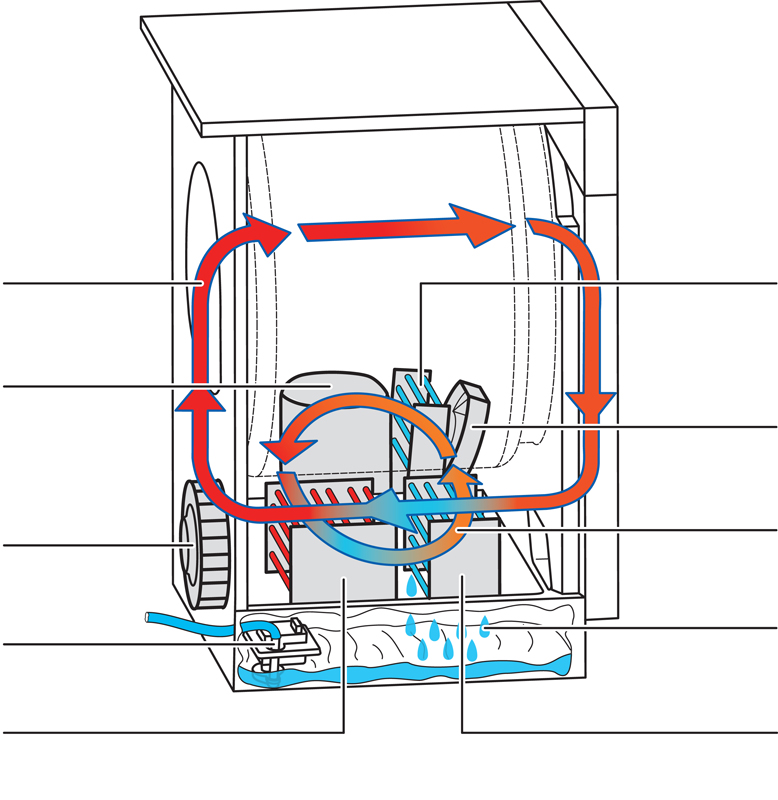
| ||
| Post# 508201 , Reply# 94 3/30/2011 at 14:14 (4,774 days old) by mielabor () | ||
|
Maytag gas dryer @foraloysius Well Louis, your link points to a site where they sell Maytag gas dryers. That's an unusual brand name in the Netherlands... | ||
| Post# 508202 , Reply# 95 3/30/2011 at 14:18 (4,774 days old) by mielabor () | ||
|
These are the specifications: CLICK HERE TO GO TO mielabor's LINK | ||
Post# 508207 , Reply# 96 3/30/2011 at 14:26 (4,774 days old) by foraloysius  (Leeuwarden, Friesland, the Netherlands) (Leeuwarden, Friesland, the Netherlands) |
||

They changed the website after I posted the link. Yes, there was an American gas dryer in that link, but it was a Huebsch dryer with top mounted controls. Huebsch is not only sold in North America, but also in Europe.
I noticed there are two other models as well, a Maytag one and a more European looking model named Hamstra. | ||
| Post# 508212 , Reply# 97 3/30/2011 at 14:54 (4,774 days old) by 3beltwesty () | ||
|
What is the typical wattage of non us condensor dryers? | ||
| Post# 508213 , Reply# 98 3/30/2011 at 14:57 (4,774 days old) by 3beltwesty () | ||
|
Is the wattage such that one needs a higher current socket; or is it low enough that it is the same 230 volt plug/socket that all ones other stuff uses? | ||
Post# 508215 , Reply# 99 3/30/2011 at 15:03 (4,774 days old) by logixx  (Germany) (Germany) |
||
 | ||
Post# 508217 , Reply# 100 3/30/2011 at 15:23 (4,774 days old) by chestermikeuk  (Rainhill *Home of the RailwayTrials* Merseyside,UK) (Rainhill *Home of the RailwayTrials* Merseyside,UK) |
||

Heres the spec for the V-Zug Heat Pump Dryer @6kg load, impressive for the energy usage!!!
OMG I`ve just realised the sticker is still on...Lol it will be vintage like the stuff we find with the stickers on...is that chavvy in shavvy or good thinking!!! Voltage: 230 volt Connected loads:1.5 kilowatt Fuse protection:10 amps Energy efficiency:A+ Better than energy: class:A-30% Energy consumption: 1.94 kWh 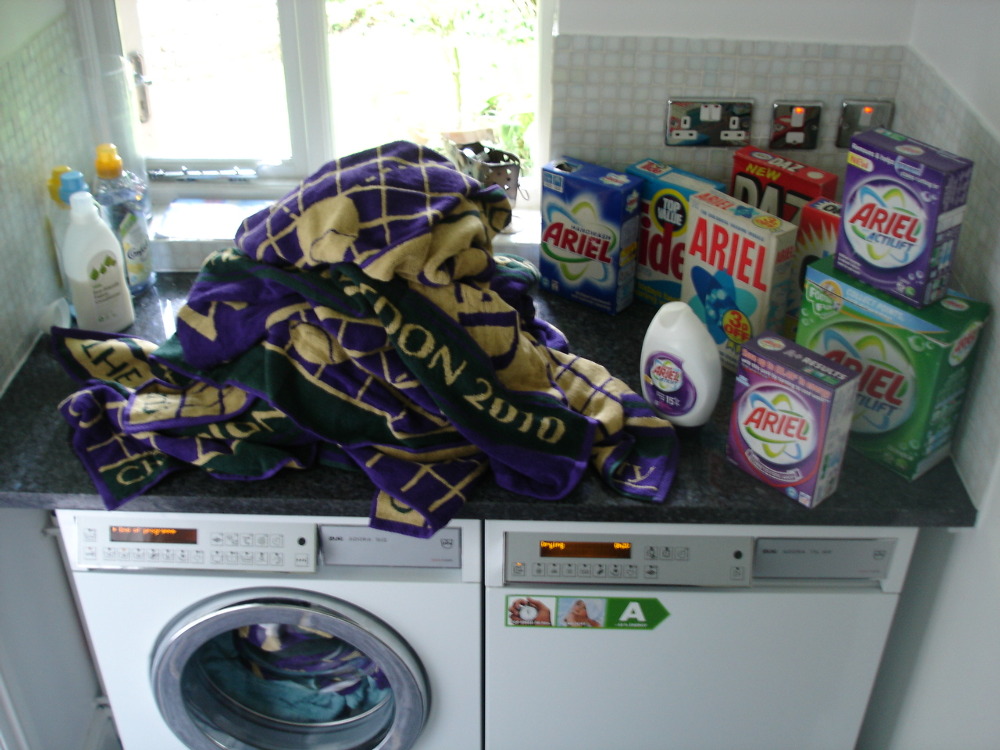
| ||
Post# 508254 , Reply# 101 3/30/2011 at 19:35 (4,774 days old) by combo52  (50 Year Repair Tech Beltsville,Md) (50 Year Repair Tech Beltsville,Md) |
||
POWER USAGE OF HEAT-PUMP DRYER | ||
Post# 508265 , Reply# 102 3/30/2011 at 20:05 (4,774 days old) by Launderess  (Quiet Please, There´s a Lady on Stage) (Quiet Please, There´s a Lady on Stage) |
||
2kW Allot Of Power For A Dryer?
Oh I don't know.
My Pfaff rotary ironer (made in Germany) pulls 2.05kW for the heater, 1kW for the steam boiler, and about 95w for the motor. OTHO my vintage Frigidaire ironer pulls about 1570 watts with a roller size just several inches shorter than the Pfaff. Is there a difference in performance? What I have noticed is that the Euro ironer not only heats up faster (comes to max temp in <8min), maintains heat and in general is able to run hotter than the Frigidare. Even over damp linens will be dry in about one pass with the Pfaff, whilst the Frigidare may take two. Methinks therefore the rationale for pulling so much power is that higher heat is not only reached faster, but less juice is required to keep it there. This probably leads to less energy use for a dryer as the load is finished quicker. | ||
| Post# 508268 , Reply# 104 3/30/2011 at 20:18 (4,774 days old) by favorit () | ||
|
Apples & Oranges ...... M.me Lavandeuse, ne melanger pas les pommes avec les oranges *LOL* We are talking about energy consuumption, not power/wattage of appliances More powerful coils/heters do not mean higher energy consumption | ||
Post# 508304 , Reply# 106 3/31/2011 at 00:06 (4,774 days old) by foraloysius  (Leeuwarden, Friesland, the Netherlands) (Leeuwarden, Friesland, the Netherlands) |
||

I just did a load in my Miele condenser dryer, laundry was spun at 1400rpm. It was an almost full drum in the Miele washer. It took exactly an hour till it hit the cool down. The total Wattage the dryer can take is 2880 Watts, including the motor, but ofcourse the element isn't continuously heating. I have no loose powermeter, so I can't measure.
Mike, did you measure the power usage with a meter? 1.94kWh sounds a bit much for a heat pump dryer. | ||
Post# 508316 , Reply# 108 3/31/2011 at 05:10 (4,774 days old) by chestermikeuk  (Rainhill *Home of the RailwayTrials* Merseyside,UK) (Rainhill *Home of the RailwayTrials* Merseyside,UK) |
||
"1.94kWh sounds a bit much for a heat pump dryer"
This is the official TEST figures for a 6kg Cotton Load, havnt popped a test meter on it yet, I did the same load of towels myself spun at 1600rpm, placed them in the Maytag condenser dryer and it took 20mins more...(1hr 20)
I think like anything else the technology will improve considerably as time moves on!! Anyone else used a Heat Pump Euro Dryer yet?? | ||
Post# 508331 , Reply# 109 3/31/2011 at 07:45 (4,774 days old) by combo52  (50 Year Repair Tech Beltsville,Md) (50 Year Repair Tech Beltsville,Md) |
||
POWER CONSUMPTION OF CLOTHES DRYERS Thanks for all the good input on this topic. I have always been very interested in the cost of power [ electricity, gas natural and propane, heating oil and the cost of water etc. ] I am always amazed that most people have no idea what these necessities of life cost but they could tell you what they paid for a gallon of gasoline or even a gallon of milk.
For years I have kept two kilowatt meters hooked up in my shop and I love to monitor the cost of drying a load of clothing in different dryers and different loads spun out in different washers. I have also calculated the cost of running lots of different refrigerators, the cost of running the self-cleaning cycle on a lot of different US electric ranges, even the cost of running my hot tub month after month.
But back to heat-pump dryers, I did expect to see a lower total power consumption per load than almost two KWs of power used. For example when I run 29" WP built dryer with a 5600 watt heater it will dry a 10 lb + load in just over an hour using a total of about 5 KWs of power and this load is being spun in a WP DD washer spinning at 640 RPMs for just 6 minutes. If I put this same size and condition load in my 1962 Frigidare custom Imperial air-cooled condensing dryer it will take an hour and 20-30 minutes and use over 6 1/2 KWs of total power. The dryer has a 4400 watt heater.
I would love to get my hands on a heat-pump dryer to do some testing on but haven't seen any in this country yet [ if some one here sees one let me know ]. As I said in an earlier post my brother and I designed one on paper many years ago we are still talking about building one. And I think they will seem like gift from the gods for people with venting problems or without natural gas but it doesn't seem when you consider the complexity and cost of the machine or the cost of operation that they will knock gas dryers off as the most environmentally friendly way to automatically dry clothing any time soon. | ||
| Post# 508365 , Reply# 110 3/31/2011 at 12:16 (4,773 days old) by limey () | ||
|
Kw and Kwh Combo A’ kilowatt’ (Kw) is the instantaneous power being used, a ‘kilowatt hour’ (Kwh) is an average of one kilowatt being used for one hour. Your electric meters measure Kwh. | ||
| Post# 508371 , Reply# 111 3/31/2011 at 12:34 (4,773 days old) by mrx () | ||
|
results to follow I have a plug-in kWh meter and I will be doing a load of towels later on. I will wash it in the Bosch Logixx 8kg (17.6lbs) machine at 60ºC (140ºF) and spin at 1600rpm Then dry in a Miele dryer. I'll give you details of kWh used for each stage. | ||
| Post# 508419 , Reply# 113 3/31/2011 at 16:01 (4,773 days old) by gorenje (Slovenia) | ||
in Slovenia
Here in Slovenia based on the last statistic 30% of the households own a dryer. (or a combo) Condenser dryers are the most common and the most available in the stores. I think very few households have a vented dryer.
14% of those who own a dryer use it also during the summer time (or when the weather is fine) In my Country the winters can be quite cold and in the Capital city the weather during the winter time is in some period quite foggy so a dryer realy isn't a strange thing to be seen. I live in a region wher we have quite enough windy weather so we can also dry outside. For me using the dryer is part of the washing process. I use it all the times. (I am part of that 14%) I rarely dry outside mainly because what comes from the dryer don't need to be iron. Here in Slovenia the electricity is quite cheap and we all have 6 KW of power. Ingemar | ||
| Post# 508450 , Reply# 115 3/31/2011 at 18:34 (4,773 days old) by Samsungfl (United Kingdom/London ) | ||
Very Interesting thread!
Nice to see a thread like this on here! Following on the above posts its suprising to see the variation of electricity different dryers use. The new Heat Pump technology really does seem impressive in terms of electricity savings!
The dryer I have, the Bendix 7442 is quite impressive I find, its maximum power consumption is only 2.3KW, which seems rather low to me as some other dryers seem to vary from this, all the way up to 3000w. However where dryers are concerned I do think powerfull airflow is key, and goes to saving electricity also. On my dryer I mostly use the Half Heat option which dries most loads within 40-60 minutes which I find more than acceptable, high heat is only used if I'm in a rush. Would also be interesting to find out how many watts the machine is drawing using the half heat option, I'm lead to believe it would be roughly 200-400w less than the full heat option, but thats purely speculation :-) Drying using slightly less heat also helps with creasing I find, ever since I've had this dryer I've never had clothes so crease free out of a tumble dryer, same goes for towels - fluffy everytime whilst retaining the scent of the detergent they where washed in. With my previous White Knight dryer I found that High heat would literally render off the majority of the scent and also cause creasing and patchy drying, though I do believe these rely more on harsh heat than the airflow. I do also have some experience using large capacity dryers at my local launderette (Gas fed, produced by ADC - American Dryer Corp.) I find these to be VERY fast however the heat thats used is far too much, when I used these most laundry would have literally no scent left at all and also be slightly rough to the touch due to the very high temperatures, but back then it was either that or wait for my compact White Knight dryer to work its way through multiple loads from my 6kilo Miele, and bear in mind each load in the dryer would be half the washers capacity, and take anywhere between 60-80 minutes to dry, which would in turn over-work the dryer and take an age to get laundry washed and dried. Keep posting guys, always nice to hear a mix of opinions on here :-) 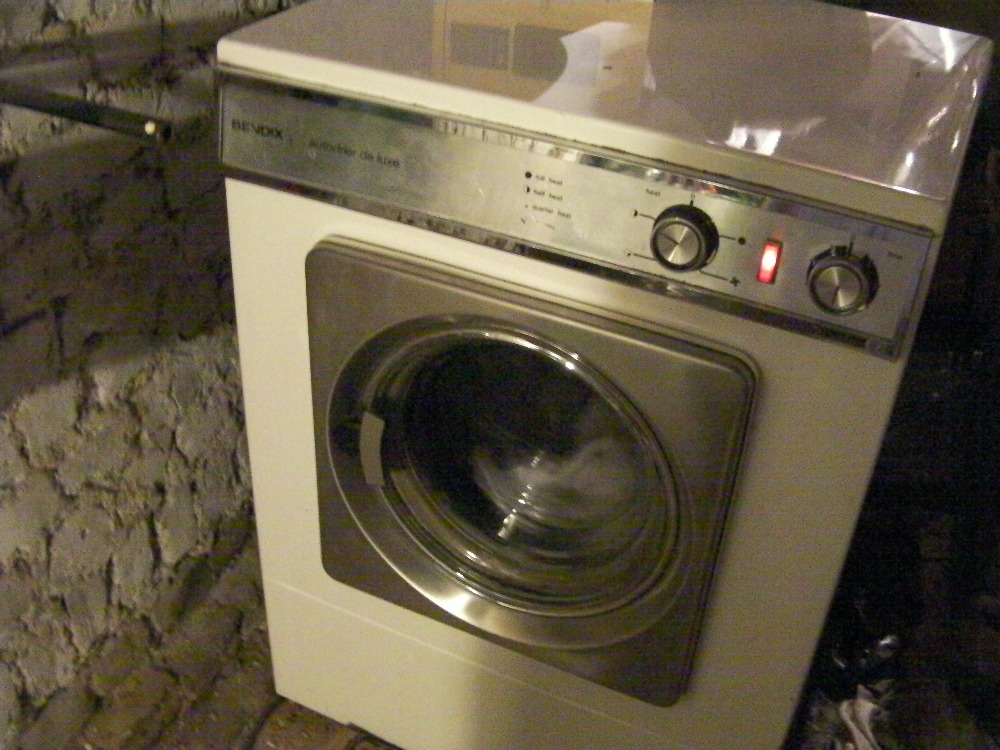
| ||
Post# 508534 , Reply# 121 4/1/2011 at 07:49 (4,773 days old) by combo52  (50 Year Repair Tech Beltsville,Md) (50 Year Repair Tech Beltsville,Md) |
||
DRYER POWER CONSUMPTION Thanks for the energy costs of electric and gas in your area mrx as you can see you can dry almost three loads with gas for the cost of drying one with electricity, this is about the same as most of the US. Gas dryers are the only gas appliance that are as efficient as there electric counterpart because there is no heat-exchanger and all of the heat from the burning gas travels through the load of tumbling clothes. Gas water heaters typically waste about 30% of the heat, gas furnaces usually waste 10-20% of the heat and gas ranges are by far the worst wasting over 50% of the heat produced. This is why there is little if any cost advantage in cooking on gas and in fact in areas of the US where electricity is cheap it can be cheaper to cook on electricity. And if you only have propane which is usually twice the cost of natural gas and electric range almost always wins.
Alex the solution for drying clothes in a dryer and having them come out with a fresh-air smell is to move your dryer outside. At least 10 years ago I installed a 1978 WP Imperial Mark 12 gas dryer out on my screened porch and it never fails to amaze me how fresh smelling the clothing comes out of the dryer, with no yucky fabric softener sheets etc. When a vented dryer is installed inside a building any background odor in the air will often smell different and worst in the clothes coming out of the dryer. These odors can come from cooking, smoking, musty basements and many cleaning products let alone floor waxes or painting or new carpeting. | ||
| Post# 508625 , Reply# 123 4/1/2011 at 15:41 (4,772 days old) by ronhic (Canberra, Australia) | ||
 From a cost perspective, an hour in the dryer is about 40cents....thats with a total power draw of 2250watts and electricity at around 15c a kilowatt hr...
Not exactly expensive...and given we have a 2.5kw solar generating system that we feed back into the grid at 44.5cents per kwh, I'm not losing any sleep over it either... | ||
| Post# 508696 , Reply# 125 4/2/2011 at 05:56 (4,772 days old) by matthewza (Cape Town, South Africa) | ||
|
the KIC was 2.7 kw on high heat and the whirlpool which is bout 3 or 4 times bigger is only either 3.0 or 3.5 kw so not bad at all. that is on high heat but as i said i use low heat most of the time. whirlpool is a 3SWED5205SQ0 SERIAL MU5104375 | ||
Post# 508813 , Reply# 127 4/2/2011 at 16:26 (4,771 days old) by logixx  (Germany) (Germany) |
||
 | ||

 Comes to the Rescue!
Comes to the Rescue!